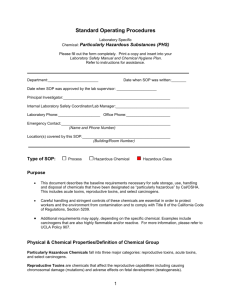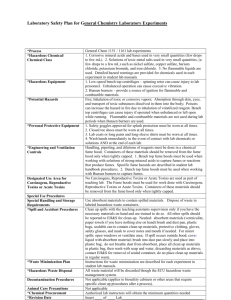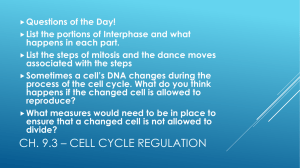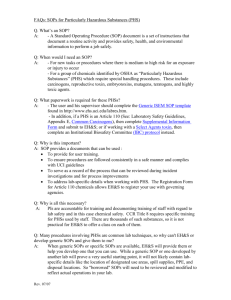Listed Carcinogens - UC Davis Safety Services
advertisement
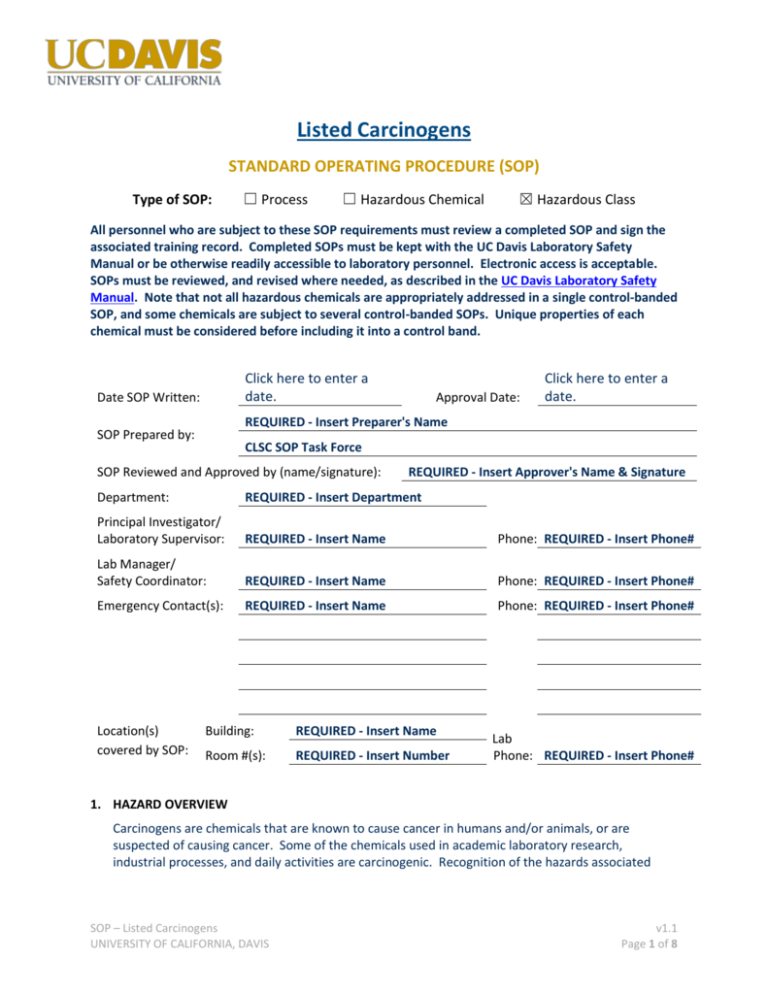
Listed Carcinogens STANDARD OPERATING PROCEDURE (SOP) Type of SOP: ☐ Process ☐ Hazardous Chemical ☒ Hazardous Class All personnel who are subject to these SOP requirements must review a completed SOP and sign the associated training record. Completed SOPs must be kept with the UC Davis Laboratory Safety Manual or be otherwise readily accessible to laboratory personnel. Electronic access is acceptable. SOPs must be reviewed, and revised where needed, as described in the UC Davis Laboratory Safety Manual. Note that not all hazardous chemicals are appropriately addressed in a single control-banded SOP, and some chemicals are subject to several control-banded SOPs. Unique properties of each chemical must be considered before including it into a control band. Click here to enter a date. Date SOP Written: Approval Date: Click here to enter a date. REQUIRED - Insert Preparer's Name SOP Prepared by: CLSC SOP Task Force SOP Reviewed and Approved by (name/signature): REQUIRED - Insert Approver's Name & Signature Department: REQUIRED - Insert Department Principal Investigator/ Laboratory Supervisor: REQUIRED - Insert Name Phone: REQUIRED - Insert Phone# Lab Manager/ Safety Coordinator: REQUIRED - Insert Name Phone: REQUIRED - Insert Phone# Emergency Contact(s): REQUIRED - Insert Name Phone: REQUIRED - Insert Phone# Location(s) covered by SOP: Building: REQUIRED - Insert Name Room #(s): REQUIRED - Insert Number Lab Phone: REQUIRED - Insert Phone# 1. HAZARD OVERVIEW Carcinogens are chemicals that are known to cause cancer in humans and/or animals, or are suspected of causing cancer. Some of the chemicals used in academic laboratory research, industrial processes, and daily activities are carcinogenic. Recognition of the hazards associated SOP – Listed Carcinogens UNIVERSITY OF CALIFORNIA, DAVIS v1.1 Page 1 of 8 with the transportation, use, storage, and disposal of these materials is essential. Precautions must be taken to minimize any potential chemical exposure to Carcinogens. 2. HAZARDOUS CHEMICAL(S)/CLASS OF HAZARDOUS CHEMICAL(S) Carcinogens are chemicals that are capable of causing cancer or tumor development, typically after repeated or chronic exposure. Their effects may only become evident after a long latency period and may cause no immediate harmful effects. Carcinogens regulated by the California Occupational Safety and Health Administration (Cal/OSHA) can be found in Title 8 of California Code of Regulations (8 CCR), Article 110, §5200-5220. One subset of these Regulated Carcinogens are typically referred to as the “Listed” Carcinogens, and are described in 8 CCR §5209. The Listed Carcinogens have more stringent requirements than other Regulated Carcinogens, and include the following materials at the specified weight/volume thresholds: Compound 2-Acetylaminofluorene 4-Aminodiphenyl Benzidine Benzidine Acetate Benzidine Dihydrochloride Benzidine Hydrochloride Benzidine Sulfate Benzidine Sulfate 3,3'-Dichlorobenzidine 3,3'-Dichlorobenzidine Dihydrochloride 3,3'-Dichlorobenzidine Dihydrogen Bis(sulphate) 3,3'-Dichlorobenzidine Hydrochloride 3,3'-Dichlorobenzidine Sulfate 4-Dimethylaminoazobenzene α-Naphthylamine β-Naphthylamine 4-Nitrobiphenyl N-Nitrosodimethylamine β-Propiolactone bis-Chloromethyl Ether Methyl Chloromethyl Ether Ethyleneimine CAS# 53-96-3 92-67-1 92-87-5 36341-27-2 531-85-1 14414-68-7 21136-70-9 531-86-2 91-94-1 612-83-9 64969-34-2 56532-21-9 74332-73-3 60-11-7 134-32-7 91-59-8 92-93-3 62-75-9 57-57-8 542-88-1 107-30-2 151-56-4 Weight/Volume Percent 1.0 0.1 0.1 0.1 0.1 0.1 0.1 0.1 1.0 1.0 1.0 1.0 1.0 1.0 1.0 0.1 0.1 1.0 1.0 0.1 0.1 1.0 Note, many carcinogens have additional chemical hazards. Review a current Safety Data Sheet for each carcinogen prior to use. REQUIRED - List (or attach) the applicable chemical(s) for your laboratory, and describe important properties and signs/symptoms of exposure. SOP – Listed Carcinogens UNIVERSITY OF CALIFORNIA, DAVIS v1.1 Page 2 of 8 3. ENGINEERING/VENTILATION CONTROLS Use available engineering/ventilation controls to keep exposure to Listed Carcinogens as low as possible. A. Containment devices (i.e.., chemical fume hoods and/or glove boxes) shall be used when: i. Using volatile and/or semi-volatile substances; ii. Manipulating substances that may generate aerosols; and iii. Performing laboratory procedures that may result in an uncontrolled release. B. High-efficiency particulate air (HEPA) filters, carbon filters, or scrubber systems with containment devices shall be used to protect effluent and vacuum lines, pumps, and the environment. For beta-propiolactone, bis-chloromethyl ether, methyl chloromethyl ether, and ethyleneimie only high efficiency scrubbers shall be used to protect laboratory vacuum systems. C. Ventilated containment shall be used to weigh out solid chemicals (e.g., ventilated balance safety enclosure). Alternatively, the tare method can be used to prevent inhalation of the chemical. While working in a fume hood, the chemical is added to a pre-weighed container. The container is then sealed and can be re-weighed outside of the fume hood. If a chemical needs to be added or removed, this manipulation is carried out in the fume hood. In this manner, all open chemical handling is conducted in the fume hood. You must contact the Chemical Hygiene Officer or healthandsafety@ucdavis.edu for a consultation before you begin work. Laboratory fume hoods where Listed Carcinogens are handled must be certified semi-annually by Facilities Management; these hoods must meet an average linear face velocity of 150 fpm, and may not be connected to any other areas through the ventilation system. Contact (530) 752-1655 if your fume hood needs updated certification. REQUIRED - Insert descriptions of lab-specific ventilation controls and equipment safety features utilized to reduce the risk of Listed Carcinogen chemical exposures. 4. ADMINISTRATIVE CONTROLS The following elements are required: 1. Complete the UC Laboratory Safety Fundamentals (or approved equivalent) training prior to working in the laboratory; 2. Complete laboratory-specific safety orientation and training on laboratory-specific safety equipment, procedures, and techniques to be used, including any applicable laboratory-specific Laboratory Safety Plan(s), prior to receiving unescorted access to the laboratory; 3. Demonstrate competency to perform the procedures to the Principal Investigator (PI), Laboratory Supervisor, laboratory-specific Safety Officer, and/or trainer; 4. Be familiar with the location and content of any applicable Safety Data Sheets (SDSs) for the chemicals to be used (online SDSs can be accessed from UC SDS); 5. Implement good laboratory practices, including good workspace hygiene; 6. Inspect all equipment and experimental setups prior to use; 7. Follow best practices for the movement, handling, and storage of hazardous chemicals (see Chapters 5 and 6 of Prudent Practices in the Laboratory for more detail). An appropriate spill cleanup kit must be located in the laboratory. Chemical and hazardous waste storage must follow an appropriate segregation scheme and include appropriate labeling. Hazardous chemical waste must be properly labelled, stored in closed containers, in secondary containment, and in a designated location; SOP – Listed Carcinogens UNIVERSITY OF CALIFORNIA, DAVIS v1.1 Page 3 of 8 8. Do not deviate from the instructions described in this SOP without prior discussion and approval from the PI and/or Laboratory Supervisor. 9. Notify the PI and/or Laboratory Supervisor of any accidents, incidents, near-misses, or upset condition (e.g., unexpected rise or drop in temperature, color or phase change, evolution of gas) involving Listed Carcinogens described in this SOP; and 10. Abide by the laboratory-specific working alone SOP, if applicable. For Listed Carcinogens, the following are also required: 11. Adhere to the UC Davis Carcinogen Program described in the Chemical Carcinogen Safety Manual and SafetyNet #32; 12. A current inventory of Listed Carcinogens shall be maintained; 13. Work surfaces must be protected (e.g., disposable absorbent bench paper, aluminum foil, etc.) and must be decontaminated after each use; 14. Mechanical pipetting shall be used for all pipetting procedures; 15. Prior to beginning work with Listed Carcinogens, an assessment of laboratory-specific procedures and equipment must be performed by the Chemical Hygiene Officer to determine if chemical exposure monitoring and medical surveillance are necessary; 16. All waste containing Listed Carcinogens at greater than 0.001% wt., including animal carcasses, must be disposed through the EH&S Hazardous Waste Program. Waste materials, including animal carcasses, containing Listed Carcinogens at less than 0.001% must be incinerated ensuring no release of carcinogenic materials. This includes all disposable PPE. All other forms of disposal are prohibited; 17. Animal research protocols involving Listed Carcinogens have several explicit requirements. Contact the Chemical Hygiene Officer or researchsafety@ucdavis.edu for assistance; and 18. Minimize your purchases of Listed Carcinogens to only the quantity: A) needed for your experiment(s), and B) to be consumed within one year. Purchases of Listed Carcinogens must be approved by EH&S. REQUIRED - Insert the laboratory-specific restrictions on maximum quanities to be used and stored. REQUIRED - Insert descriptions of any special handling or storage requirements. INSERT IF APPLICABLE - Describe any chemical exposure monitoring and medical surveilance requirements, as determined by the Chemical Hygiene Officer. INSERT IF APPLICABLE - Describe any additional administrative controls (e.g., restrictions on procedure/work equipment/work locations/unattended operations). Include any chemical-specific administrative controls (e.g., peroxide formers). 5. PERSONAL PROTECTIVE EQUIPMENT (PPE) At a minimum, long pants (covered legs) and closed toe/closed heel shoes (covered feet) are required to enter a laboratory or technical area where hazardous chemicals are used or stored. In addition to the minimum attire required upon entering a laboratory, the following PPE are required for work with Listed Carcinogens: A. Eye Protection: Eye protection is required for all work with Carcinogens. i. At a minimum ANSI Z87.1-compliant safety glasses are necessary. ii. Splash goggles may be substituted for safety glasses, and are required for processes where splashes are foreseeable or when generating aerosols. SOP – Listed Carcinogens UNIVERSITY OF CALIFORNIA, DAVIS v1.1 Page 4 of 8 iii. Ordinary prescription glasses will NOT provide adequate protection unless they also meet the Z87.1 standard and have compliant side shields. B. Body Protection: At a minimum a chemically-compatible laboratory coat that fully extends to the wrist is necessary. i. If a risk of fire exists, a flame-resistant laboratory coat that is NFPA 2112-compliant should be worn. ii. For chemicals that are corrosive and/or toxic by skin contact/absorption additional protective clothing (e.g., face shield, chemically-resistant apron, disposable sleeves, etc.) are required where splashes or skin contact is foreseeable. iii. Disposable PPE (e.g., Tyvek lab coat, Tyvek arm sleeves, etc.) must be worn over the top of other body protection for body parts that enter a regulated area (e.g., chemical fume hood) where a Listed Carcinogen is used. This disposable PPE may only be used once, and must be removed upon completion of the laboratory activity prior to exiting the regulated area. These materials must be considered contaminated after one use and disposed as hazardous waste. If you need other options for disposable PPE, contact the Chemical Hygiene Officer for assistance. C. Hand Protection: Hand protection is needed for the activities described in this SOP. Define the type of glove to be used based on: A) the chemical(s) being used, B) the anticipated chemical contact (e.g., incidental, immersion, etc.), C) the manufacturers’ permeation/compatibility data, and D) whether a combination of different gloves is needed for any specific procedural step or task. REQUIRED - Insert descriptions of PPE and hygiene practices used with the Listed Carcinogens described in this SOP. Include any specialized PPE needed for a procedural step/task. 6. SPILL AND EMERGENCY PROCEDURES Follow the guidance for chemical spill cleanup from SafetyNet #13 and/or the UC Davis Laboratory Safety Manual, unless specialized cleanup procedures are described below. Emergency procedure instructions for the UC Davis campus and UCD Medical Center are contained in the UC Davis Laboratory Safety Manual and the Emergency Response Guide (which must be posted in the laboratory). All other locations must describe detailed emergency procedure instructions below. For spills of solid materials, DO NOT dry sweep. REQUIRED - Insert descriptions of any specialized spill clean up procedures for hazardous chemicals used in this SOP (e.g., hydrofluoric acid, pyrophorics, phenol, etc.). Additional details of lab-specific spill cleanup should be provided if applicable. INSERT IF APPLICABLE - Descriptions of any specialized emergency procedures for locations outside of the UC Davis main campus and the UCD Medical Center campus. EH&S must be notified immediately for any uncontrolled release of Listed Carcinogens; please call (530) 752-1493. Some examples of an uncontrolled releases include, but are not limited to, equipment failure, rupture of containers, or failure of control equipment. EH&S must report this information to Cal/OSHA within 24 hours. 7. WASTE MANAGEMENT AND DECONTAMINATION Hazardous waste must be managed according to Safety Net #8 using the appropriate label. In general, hazardous waste must be removed from your laboratory within 9 months of the SOP – Listed Carcinogens UNIVERSITY OF CALIFORNIA, DAVIS v1.1 Page 5 of 8 accumulation start date; refer to the timeline for waste disposal. Hazardous waste pick up requests must be completed online. REQUIRED - Insert descriptions of laboratory-specific information on the waste streams generated, storage location, and any special handling/storage requirements. Decontamination procedures vary depending on the material being handled. Carefully inspect work areas to make sure no hazardous materials remain. Following dispensing or handling of Listed Carcinogens, all surfaces and equipment shall be wiped with the appropriate cleaning agent to prevent accumulation of Listed Carcinogen chemical residue. Dispose of cleaning materials properly. Be sure all ignition sources are secured before beginning clean up with flammable liquids. Decontaminate vacuum pumps or other contaminated equipment before removing them from the regulated area or before resuming normal laboratory work in the area. REQUIRED - Insert descriptions of decontamination procedures for equipment, glassware, and controlled areas (e.g., glove boxes, restricted access hoods, perchloric/hot acid fume hoods, or designated portions of the laboratory). Upon completion of work with Listed Carcinogens and/or decontamination of equipment, remove gloves and/or PPE to wash hands and arms with soap and water. Additionally, upon leaving a regulated Listed Carcinogen work area remove all PPE worn and wash hands, forearms, face and neck. Contaminated clothing or PPE shall not be removed from the laboratory/regulated area unless properly decontaminated or via disposal as hazardous waste. 8. REGULATED AREA Regulated area(s) for the use and storage of Listed Carcinogens shall be established where limited access, special procedures, knowledge, and work skills are required. Signage indicating the materials being used and/or stored and the applicable hazards should be easily visible for the regulated work space and/or storage area, for example: DANGER! CARCINOGEN WORK AREA! REQUIRED - Insert description(s) of the regulated area(s) for Listed Carcinogens in your laboratory. The entire laboratory, a portion of the laboratory, a fume hood, a specific laboratory workbench, a locked storage cabinet, etc. can be designated. 9. DETAILED PROTOCOL REQUIRED - Insert or attach detailed laboratory-specific procedures for the process, hazardous chemical(s), or hazard class. You may also include any relevant supporting resources such as SafetyNets, journal citations, etc. that are applicable. SOP – Listed Carcinogens UNIVERSITY OF CALIFORNIA, DAVIS v1.1 Page 6 of 8 TEMPLATE REVISION HISTORY Version 1.0 1.1 Date Approved 4/14/2015 11/03/15 Author CLSC Task Force Chris Jakober Revision Notes: New template Added new chemical in Table in Section 2 LAB-SPECIFIC REVISION HISTORY Version Date Approved SOP – Listed Carcinogens UNIVERSITY OF CALIFORNIA, DAVIS Author Revision Notes: v1.1 Page 7 of 8 Documentation of Standard Operating Procedure Training (Signature of all users is required) Prior to using Listed Carcinogens, laboratory personnel must be trained on the hazards described in this SOP, how to protect themselves from the hazards, and emergency procedures. Ready access to this SOP and to a Safety Data Sheet for each hazardous material described in the SOP must be made available. The Principal Investigator (PI), or the Laboratory Supervisor if the activity does not involve a PI, must ensure that their laboratory personnel have attended appropriate laboratory safety training or refresher training within the last three years. Training must be repeated following any revision to the content of this SOP. Training must be documented. This training sheet is provided as one option; other forms of training documentation (including electronic) are acceptable but records must be accessible and immediately available upon request. Designated Trainer: (signature is required) I have read and acknowledge the contents, requirements, and responsibilities outlined in this SOP: Name SOP – Listed Carcinogens UNIVERSITY OF CALIFORNIA, DAVIS Signature Trainer Initials Date v1.1 Page 8 of 8

